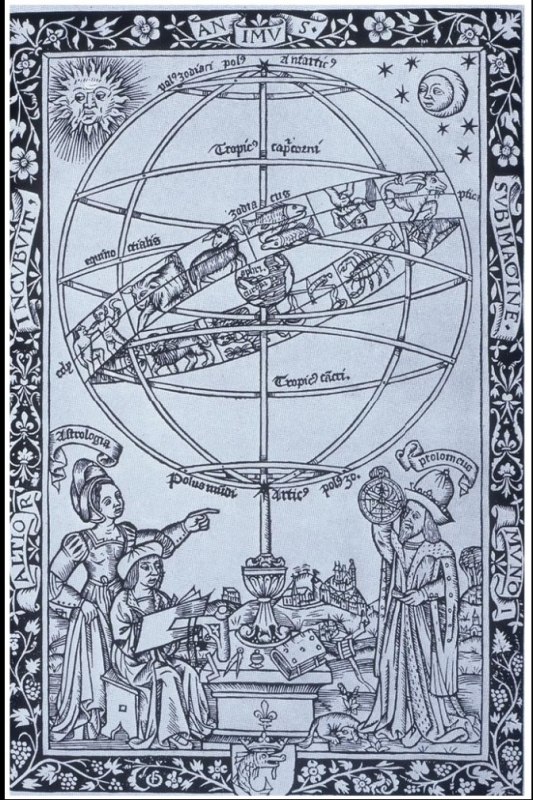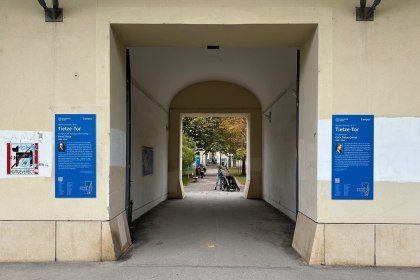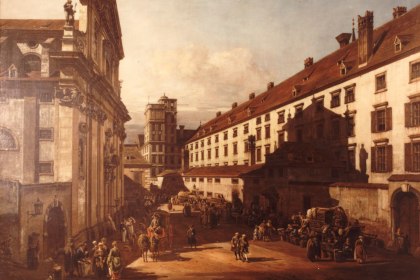Georg Aunpekh von Peuerbach, Mag. art.
(Georg Aunpeckh (Aunpeck) von Peuerbach)
Honors
| Ehrung | Titel | Datierung | Fakultät | |
|---|---|---|---|---|
| Commemorative Plaque of Faculty | 1894/1925 | Faculty of Philosophy |
|
|
| Gate of Remembrance | Peuerbach Gate | 1998 |
|
- Astronomy
- Astrology
- Faculty of Philosophy
The famous astronomer and mathematician Georg Aunpekh grew up in a large family in the Hausruckviertel region of Upper Austria. He was traditionally named after his birthplace and place of origin, the present-day municipality of Peuerbach (Grieskirchen district). The up-and-coming town had already been granted market rights in 1280. The priest Henricus Baruther (died May 12, 1454) played an important role in the education of Peuerbach's youth. He had obtained his Magisterium artium in Paris and taught as a Doctor of Canon Law at the Faculty of Theology at the University of Vienna. He is said to have encouraged many parishioners to study in Vienna, whose university was the most visited university in the empire at the time. However, Georg first attended the Klosterneuburg monastery, where he received a comprehensive mathematical education and perhaps also came into contact with the founder of the first Viennese mathematical-astronomical school, Johannes von Gmunden. In the summer semester of 1446, Georg Aunpekh was enrolled – relatively late (at the age of 23) – at the University of Vienna, where he obtained his bachelor's degree in 1448 and his licentiate in 1452 at the Faculty of Arts.
Between 1448 and 1451, the young scholar undertook an extensive journey to Italy to the centers of humanist education, where he met important scholars. At the University of Padua, he probably made the acquaintance of the highly educated Cardinal Nikolaus von Kues (Cusanus). He gave lectures here himself in 1449. He then probably spent time in Rome and Florence, where he presumably met the famous physician, mathematician and astronomer Paolo dal Pozzo Toscanelli. In Ferrara, he may also have met the Italian astronomer Giovanni Bianchini. In March 1451, Aunpekh returned to Vienna in the entourage of Cardinal Nikolaus Cusanus and moved to the imperial court in Wiener Neustadt around 1453, where a circle of humanist scholars gathered around Enea Silvio Piccolomini (later Pope Pius II). He then became court astrologer to King Ladislaus Postumus, with whom he traveled to Hungary, where he met the future Archbishop of Gran/Esztergom, Jan Vitéz. The young Aunpeckh quickly became known in scholarly circles and was held in high esteem. After the death of King Ladislaus (1457), he entered the service of Emperor Frederick III (+1493), who was particularly interested in astrology. Here he also made a living by producing calendars and bloodletting slips (cedulae minuciorum, i.e. instructions for bloodletting taking astrological influences into account).
On February 28, 1453, Peuerbach was awarded his Magister artium at the University of Vienna and in 1457, together with his student and close friend Johannes Müller von Königsberg, known as Regiomontanus, he was admitted as Magister actu regens. His lectures were devoted to the Latin classics Virgil, Juvenal, Pseudo-Cicero and Horace. He never taught the quadrivial (scientific) subjects at the university. He may have presented his planetary theory in 1454 at the St. Stephen's School in Vienna. In 1456, at the request of the Faculty of Arts, he dedicated at least an expert report on his observations of the appearance of Halley's Comet and another comet. In addition to lectures on Aristotle's theory of the heavens (De caelo), lectures on planetary theories, e.g. by Gerhard von Sabbioneta, can be traced back to the end of the 14th century.
In 1460, the Byzantine humanist, theologian and philosopher Cardinal Bessarion, founder of the Platonic Academy in Rome, gave Peuerbach the task of translating and explaining the Almagest, the main work of ancient astronomy by Claudius Ptolemy. After the scholar's early death (1461), his pupil and friend Regiomontanus took over the completion of this work (Epitoma in Almagestum), which was not printed until after his death in Venice in 1496. It was one of the most important foundations of astronomy. The „humanistic natural science“ that emerged in Vienna with Georg von Peuerbach aimed at the linguistic purification (castigatio) of ancient, primarily scientific, texts from the quadrivium (arithmetic, geometry, music, astronomy/astrology), while the studia humaniora had previously concentrated on the philological subjects of the trivium (grammar, rhetoric, dialectics).
Peuerbach's seminal astronomical magnum opus, Theoricae Novae Planetarum, a critical examination of the various ancient planetary theories, was completed by the scholar in 1454. It was only after his death that Regiomontanus was able to publish it in print in Nuremberg in 1473. It became a standard work of astronomical research and went through numerous editions. Many manuscripts of his astronomical and mathematical works have also survived. The TABULAE ECLIPSIUM, the „eclipse tables“, which he wrote in 1459, are predictions of solar and lunar eclipses with only minor deviations and were printed in 1514.
Peuerbach also showed great talent as a craftsman. He made astronomical observation instruments such as folding and wall-mounted sundials and astrolabes. Emperor Frederick III was particularly fond of them. Among other things, Peuerbach created a magnificent astrolabe and a brass folding sundial for him, whereby he discovered the fact that the geographic and magnetic North Pole differed from each other. He marked this deviation in his folding sundials, which improved their precision. Aunpekh also recognized the possibilities of the sine calculation and the applicability of the angle function calculation in surveying and astronomy with regard to the calculation of solar altitudes for all geographical latitudes and hours. Finally, his poetic talent should also be mentioned.
The „First Viennese mathematical-astronomical school“, to which the scholars Johannes von Gmunden, Georg von Peuerbach and Johannes Regiomontanus, who were active in Vienna, are counted in the literature, was first commemorated by the later humanist natural scientist Georg Tannstetter in his work Viri mathematici in 1514. After his early death, Peuerbach was buried in 1461 in the tomb of the university professors in St. Stephen's Cathedral in the Apostles' Choir. A wooden epitaph was placed here, which is now lost. On March 12, 1999, a memorial plaque was unveiled in this area, which contains a burial verse dating back to Peuerbach. The depicted formula refers to the application of the sine calculation for surveying and astronomy, which he discovered.
The University of Vienna honored Georg Aunpekh von Peuerbach in 1893 by naming him on the honorary plaque of the Faculty of Philosophy and in 1998 by naming one of the „Gates of Remembrance“ on the campus of the University of Vienna (Peuerbach Gate, passageway from court 6 to court 7).
Zuletzt aktualisiert am 03/01/24
-
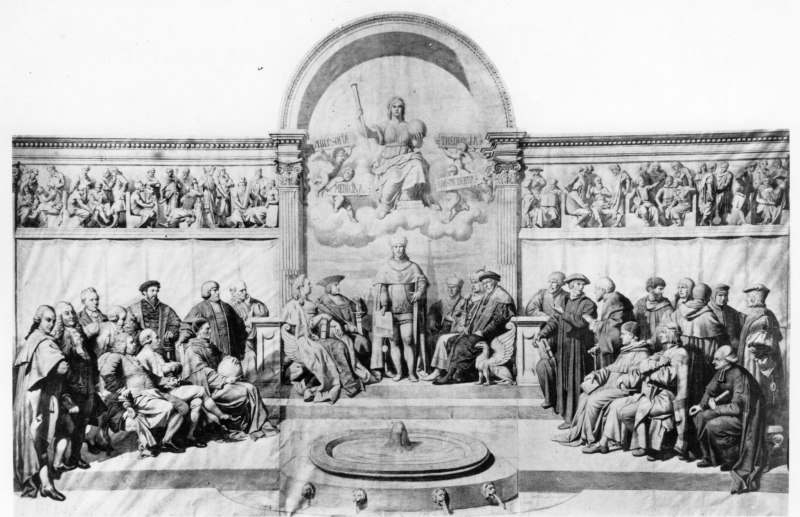
Allegory for the quincentenary 1865: The patrons and most famous teachers of the University of Vienna
Photography of the cartoon by Carl Swoboda for the quincentenary of the University of Vienna . Pictured from the left are: Franz Ferdinand von...
-
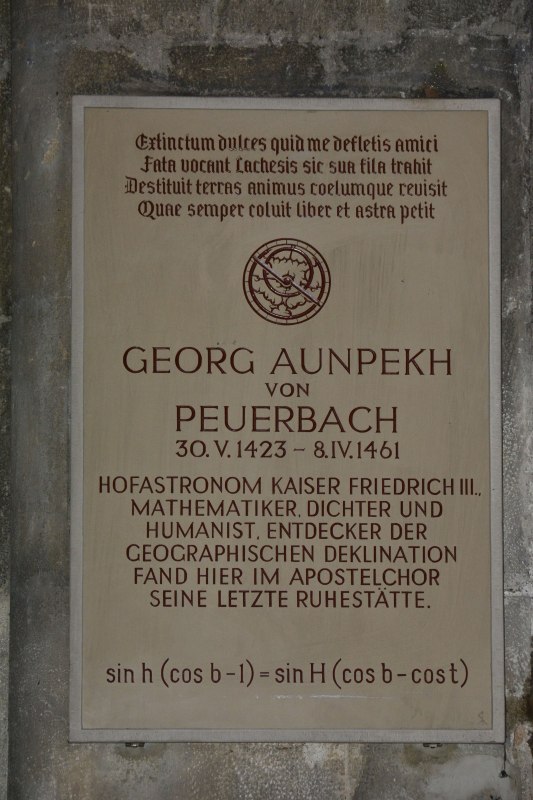
Epitaph für Georg von Peuerbach im Wiener Stephansdom
Das ursprüngliche Epitaph Georg von Peuerbachs im Wiener Stephansdom ist nicht erhalten. 1999 wurde im Apostelchor eine Gedenktafel für Peuerbach...

